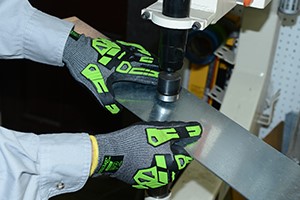At Risk for Impact Injuries? Read this.

When it comes to our hands, it’s hard to imagine what we’d do or how we’d function in our day-to-day lives without them. From tying our shoes, to driving, to signing our names, we depend on our hands immeasurably. For people on the job, losing the use of their hands due to an accident is both problematic and traumatic.
A good supervisor makes safety a priority, and reducing injuries caused by blows, pinching, and impact is a fundamental part of hand and finger safety in the workplace. Accidents involving the fingers, palm, and back (dorsal) side of the hands lead to fractures, severe bruising, and crushing, prompting emergency room visits for many industries across the country.
While the employee is dealing with the injury, pain, and recovery time, the employer has to contend with workers’ compensation costs, decreased productivity, higher insurance rates, and decreased morale. An effective hand protection plan goes a long way in providing a positive work environment that enhances the company’s safety culture.
Impact Protection
Because our hands move quickly and frequently, painful blows can happen easily. Accidents from impact and pinching can be caused by tools, machinery, striking hard surfaces, heavy equipment, and more.
Impact-resistant gloves play a major role in preventing accidents. Innovative materials like Thermal Plastic Rubber (TPR) protect vulnerable areas like the top of the hand and full length of the fingers. Strategically placed, dense padding in crucial areas can also deflect blows.
One particular area susceptible to injury is the back of the hands. This part of our anatomy is just as important to keeping our hands functioning as the palms, but unfortunately, this dorsal side lacks the padding from bigger muscles and thicker skin that’s found in the palms. The use of TPR to absorb and disperse impact is especially helpful in preventing pain from blows to this vulnerable area. Today, glove manufacturers are recognizing this need and have developed gloves to protect this part of the hand.
Another way to increase hand protection is to increase hand position awareness. The use of high visibility materials like reflective striping on gloves draws the worker’s attention to the task and where their hands are in relation to the tools and environment. This is especially effective in low or varied lighting conditions.
Beyond Gloves
Providing hand protection is more than just handing out gloves. When possible, administrative and engineering controls, including machine guards, should be used to eliminate hazards. After all, if hands are out of harm’s way, accidents can be prevented. When gloves are required, workers should be trained by someone knowledgeable in the employer’s safety policies and processes. Some important ongoing training topics include recognizing hazards, safe practices, and the gloves’ use, fit, and care, including identifying when gloves no longer provide adequate protection. Employers must regularly reinforce the value of wearing gloves and practicing safe work methods.
Not to be overlooked are factors unrelated to gloves including workplace set-up, working conditions, and improved lighting.
Tools, heavy loads, and machinery can be tough on hands. Efforts to eliminate hand injuries provide a wide range of immediate benefits. The use of impact-resistant gloves and ongoing employee training are crucial steps in protecting workers from fractures, bruising, and crushing injuries.


